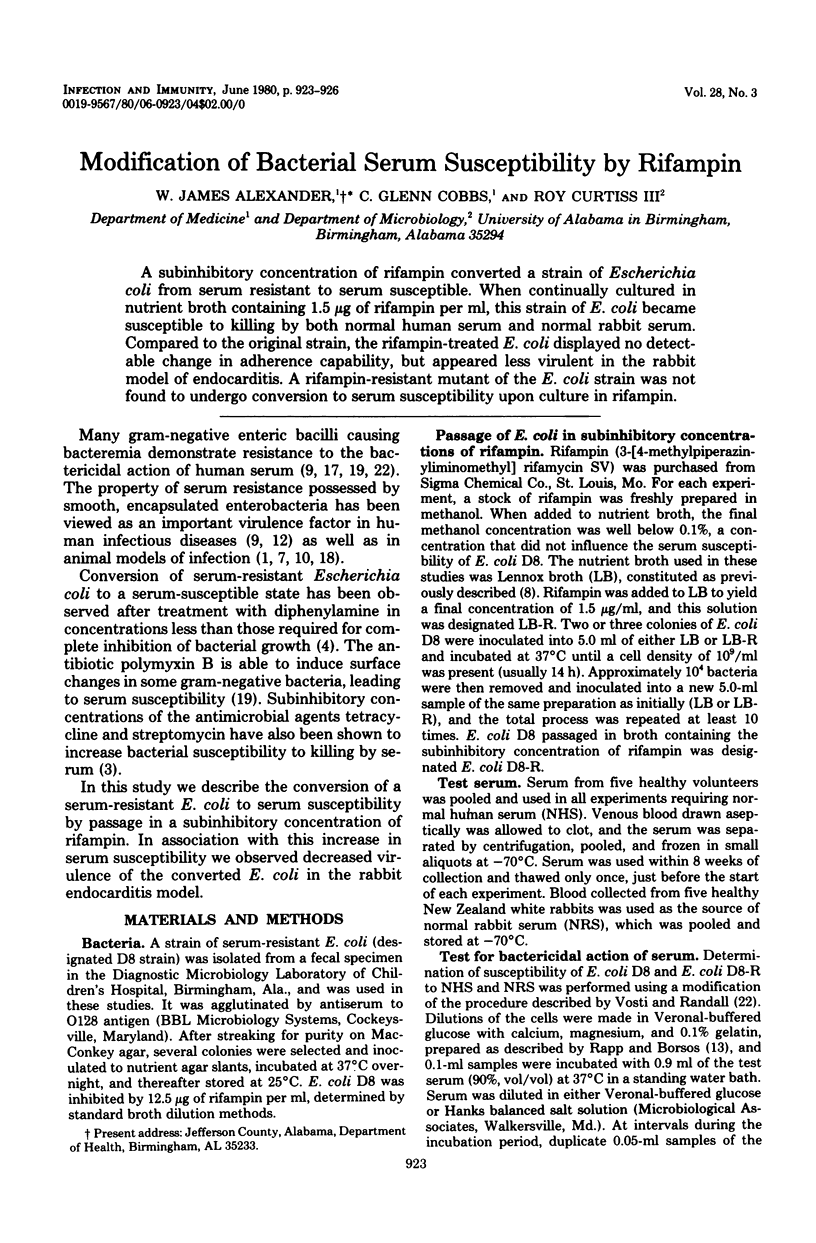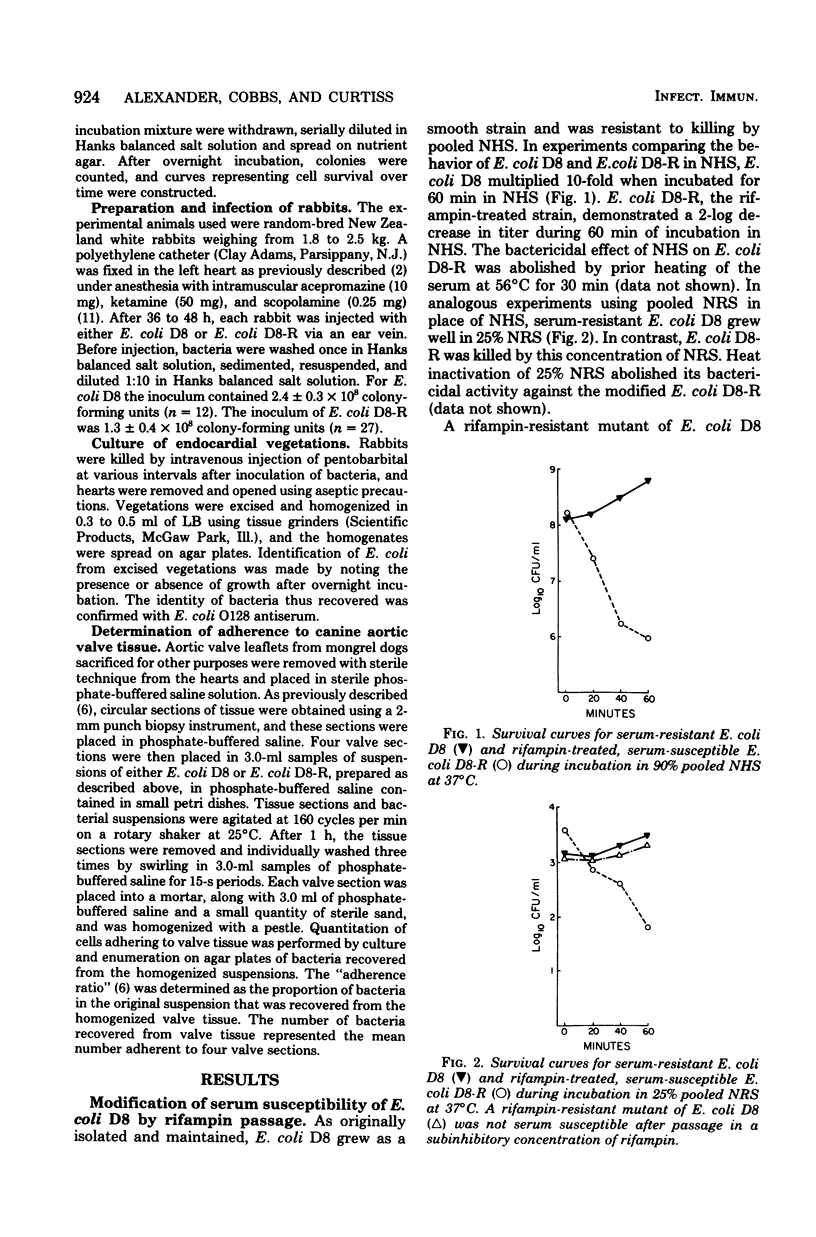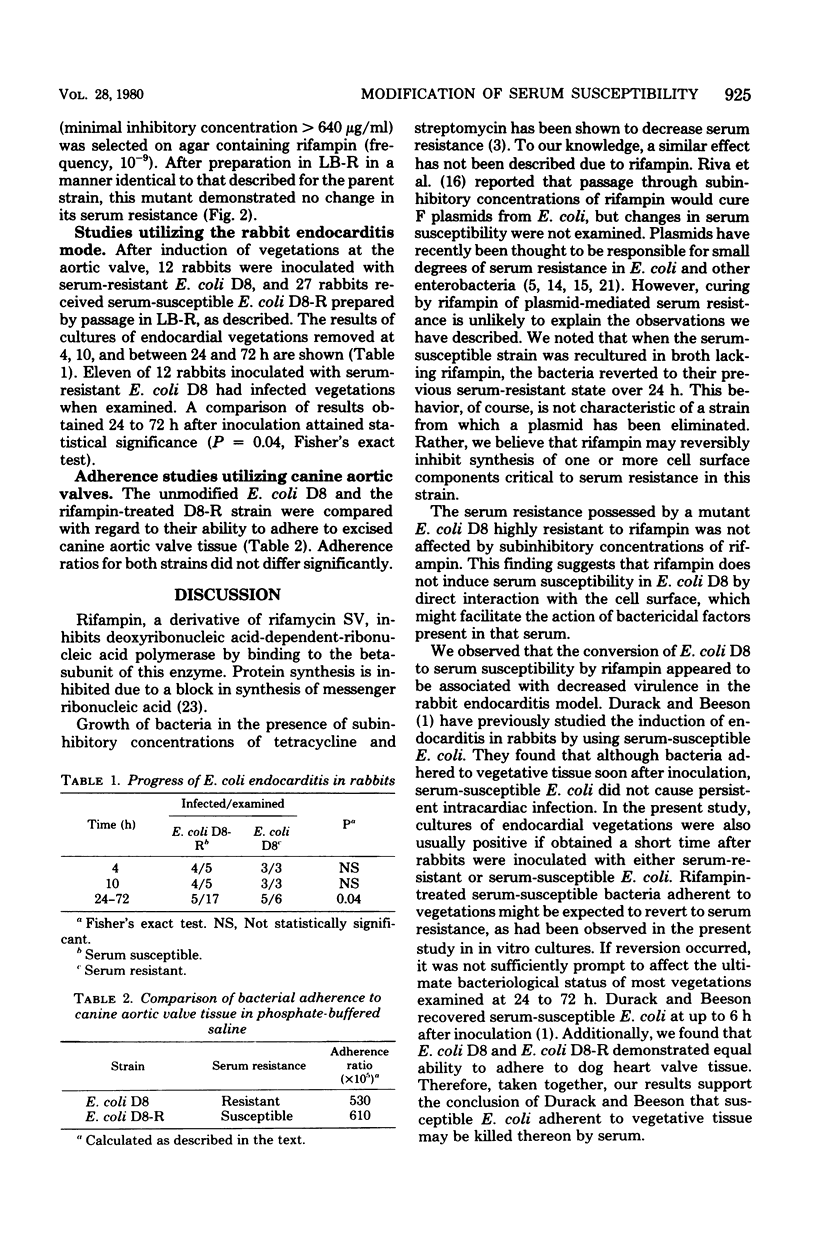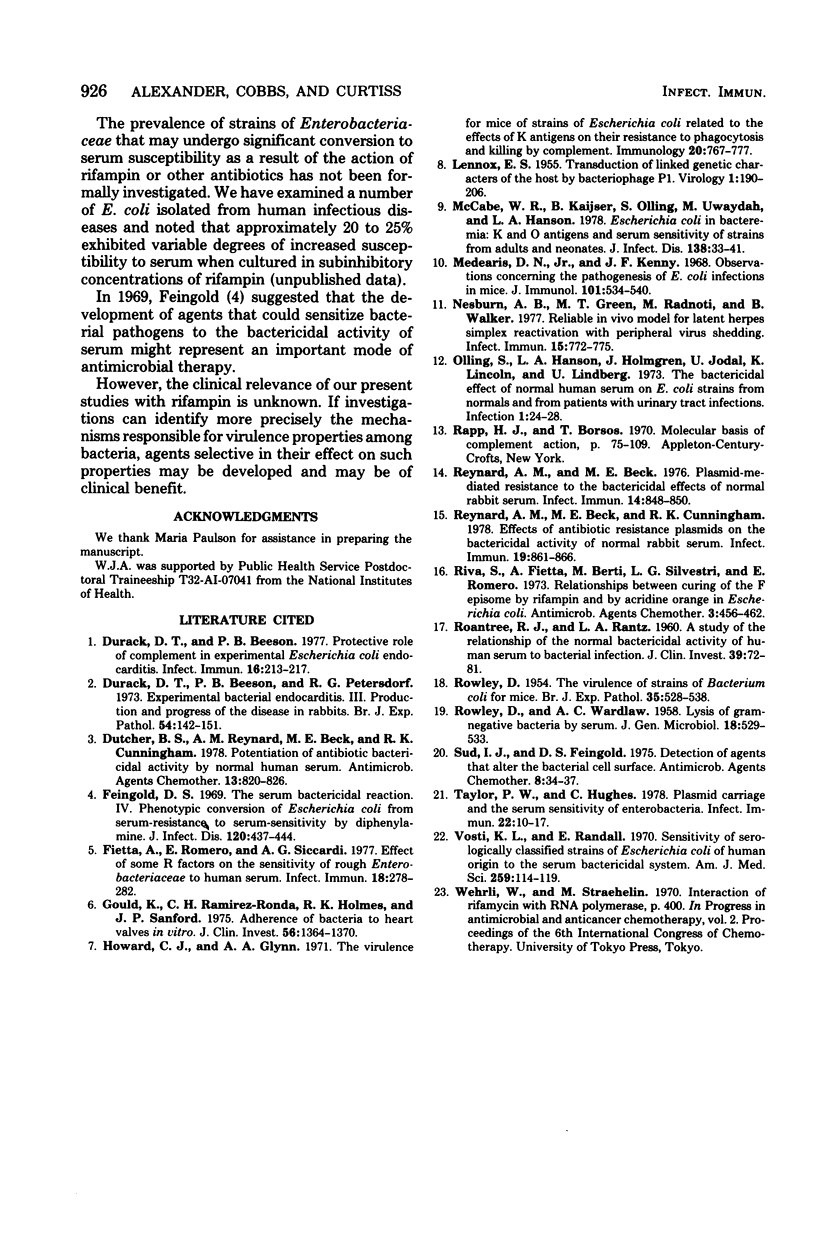Abstract
A subinhibitory concentration of rifampin converted a strain of Escherichia coli from serum resistant to serum susceptible. When continually cultured in nutrient broth containing 1.5 microgram of rifampin per ml, this strain of E. coli became susceptible to killing by both normal human serum and normal rabbit serum. Copared to the original strain, the rifampin-treated E. coli displayed no detectable change in adherence capability, but appeared less virulent in the rabbit model of endocarditis. A rifampin-resistant mutant of the E. coli strain was not found to undergo conversion to serum susceptibility upon culture in rifampin.
Full text
PDF



Selected References
These references are in PubMed. This may not be the complete list of references from this article.
- Durack D. T., Beeson P. B., Petersdorf R. G. Experimental bacterial endocarditis. 3. Production and progress of the disease in rabbits. Br J Exp Pathol. 1973 Apr;54(2):142–151. [PMC free article] [PubMed] [Google Scholar]
- Durack D. T., Beeson P. B. Protective role of complement in experimental Escherichia coli endocarditis. Infect Immun. 1977 Apr;16(1):213–217. doi: 10.1128/iai.16.1.213-217.1977. [DOI] [PMC free article] [PubMed] [Google Scholar]
- Dutcher B. S., Reynard A. M., Beck M. E., Cunningham R. K. Potentiation of antibiotic bactericidal activity by normal human serum. Antimicrob Agents Chemother. 1978 May;13(5):820–826. doi: 10.1128/aac.13.5.820. [DOI] [PMC free article] [PubMed] [Google Scholar]
- Feingold D. S. The serum bactericidal reaction. IV. Phenotypic conversion of Escherichia coli from serum-resistance to serum-sensitivity by diphenylamine. J Infect Dis. 1969 Oct;120(4):437–444. doi: 10.1093/infdis/120.4.437. [DOI] [PubMed] [Google Scholar]
- Fietta A., Romero E., Siccardi A. G. Effect of some R factors on the sensitivity of rough Enterobacteriaceae to human serum. Infect Immun. 1977 Nov;18(2):278–282. doi: 10.1128/iai.18.2.278-282.1977. [DOI] [PMC free article] [PubMed] [Google Scholar]
- Gould K., Ramirez-Ronda C. H., Holmes R. K., Sanford J. P. Adherence of bacteria to heart valves in vitro. J Clin Invest. 1975 Dec;56(6):1364–1370. doi: 10.1172/JCI108216. [DOI] [PMC free article] [PubMed] [Google Scholar]
- Howard C. J., Glynn A. A. The virulence for mice of strains of Escherichia coli related to the effects of K antigens on their resistance to phagocytosis and killing by complement. Immunology. 1971 May;20(5):767–777. [PMC free article] [PubMed] [Google Scholar]
- Jit Sud I., Feingold D. S. Detection of agents that alter the bacterial cell surface. Antimicrob Agents Chemother. 1975 Jul;8(1):34–37. doi: 10.1128/aac.8.1.34. [DOI] [PMC free article] [PubMed] [Google Scholar]
- LENNOX E. S. Transduction of linked genetic characters of the host by bacteriophage P1. Virology. 1955 Jul;1(2):190–206. doi: 10.1016/0042-6822(55)90016-7. [DOI] [PubMed] [Google Scholar]
- McCabe W. R., Kaijser B., Olling S., Uwaydah M., Hanson L. A. Escherichia coli in bacteremia: K and O antigens and serum sensitivity of strains from adults and neonates. J Infect Dis. 1978 Jul;138(1):33–41. doi: 10.1093/infdis/138.1.33. [DOI] [PubMed] [Google Scholar]
- Medearis D. N., Jr, Kenny J. F. Observations concerning the pathogenesis of E. coli infections in mice. J Immunol. 1968 Sep;101(3):534–540. [PubMed] [Google Scholar]
- Nesburn A. B., Green M. T., Radnoti M., Walker B. Reliable in vivo model for latent herpes simplex virus reactivation with peripheral virus shedding. Infect Immun. 1977 Mar;15(3):772–775. doi: 10.1128/iai.15.3.772-775.1977. [DOI] [PMC free article] [PubMed] [Google Scholar]
- Olling S., Hanson L. A., Holmgren J., Jodal U., Lincoln K., Lindberg U. The bactericidal effect of normal human serum on E. coli strains from normals and from patients with urinary tract infections. Infection. 1973;1(1):24–28. doi: 10.1007/BF01638251. [DOI] [PubMed] [Google Scholar]
- ROWLEY D. The virulence of strains of Bacterium coli for mice. Br J Exp Pathol. 1954 Dec;35(6):528–538. [PMC free article] [PubMed] [Google Scholar]
- ROWLEY D., WARDLAW A. C. Lysis of gram-negative bacteria by serum. J Gen Microbiol. 1958 Apr;18(2):529–533. doi: 10.1099/00221287-18-2-529. [DOI] [PubMed] [Google Scholar]
- Reynard A. M., Beck M. E., Cunningham R. K. Effects of antibiotic resistance plasmids on the bactericidal activity of normal rabbit serum. Infect Immun. 1978 Mar;19(3):861–866. doi: 10.1128/iai.19.3.861-866.1978. [DOI] [PMC free article] [PubMed] [Google Scholar]
- Reynard A. M., Beck M. E. Plasmid-mediated resistance to the bactericidal effects of normal rabbit serum. Infect Immun. 1976 Sep;14(3):848–850. doi: 10.1128/iai.14.3.848-850.1976. [DOI] [PMC free article] [PubMed] [Google Scholar]
- Riva S., Fietta A., Berti M., Silvestri L. G., Romero E. Relationships between curing of the F episome by rifampin and by acridine orange in Escherichia coli. Antimicrob Agents Chemother. 1973 Apr;3(4):456–462. doi: 10.1128/aac.3.4.456. [DOI] [PMC free article] [PubMed] [Google Scholar]
- Roantree R. J., Rantz L. A. A STUDY OF THE RELATIONSHIP OF THE NORMAL BACTERICIDAL ACTIVITY OF HUMAN SERUM TO BACTERIAL INFECTION. J Clin Invest. 1960 Jan;39(1):72–81. doi: 10.1172/JCI104029. [DOI] [PMC free article] [PubMed] [Google Scholar]
- Taylor P. W., Hughes C. Plasmid carriage and the serum sensitivity of enterobacteria. Infect Immun. 1978 Oct;22(1):10–17. doi: 10.1128/iai.22.1.10-17.1978. [DOI] [PMC free article] [PubMed] [Google Scholar]
- Vosti K. L., Randall E. Sensitivity of serologically classified strains of escherichia coli of human origin to the serum bactericidal system. Am J Med Sci. 1970 Feb;259(2):114–119. doi: 10.1097/00000441-197002000-00005. [DOI] [PubMed] [Google Scholar]


